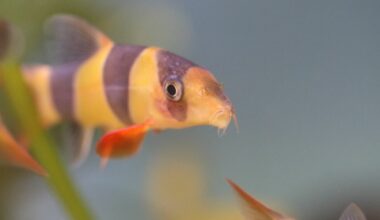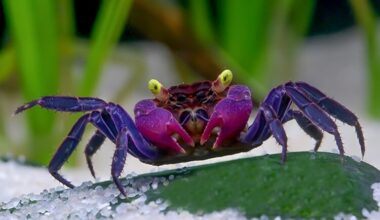Frogspawn coral (Euphyllia divisa) is a very popular option for reef aquarium owners, and it’s not hard to see why. This large polyp stony coral is absolutely stunning to look at!
Despite its popularity, there’s a bunch of misinformation being passed around online when it comes to frogspawn coral care. This sabotages new owners who end up seeing inaccurate info regarding ideal water parameters, lighting, and placement.
That’s why we made this guide. In it, you’ll learn everything you need to know about frogspawn coral care so you can help yours thrive!
Table of Contents
Species Summary
Frogspawn coral is a species that can be found in a variety of places around the world. Australia, Fiji, Southeast Asia, the Soloman Island, and the Ryukyu Islands are all spots where Euphyllia divisa can be readily found.
Sometimes you’ll hear frogspawn coral be called wall coral, grape coral, octopus coral, or honey coral. For the sake of clarity, we prefer to refer to it by its common name (and occasionally its scientific one).
Unlike some other species of coral, frogspawn polyps stay out 24/7 which makes it great for viewing in a home tank.
Frogspawn coral is a fairly hardy species that can tolerate a decent range of water parameters and conditions. With that being said, a lot of people overestimate it when it comes to care (and this can have dire consequences).
Its ideal environment is in depths of 120-140 feet. It doesn’t like sandy bottoms and thrives where there’s more muck. Although it’s known for aggression when it comes to bullying other corals for space, they end up in rather modest colony sizes.
Appearance
The appearance of frogspawn coral is one of the most common reasons why people add them to their tanks. This coral is really something to see, and when you combine it with interesting lighting it enhances their look even more!
When it comes to the structural makeup of this species, it will vary depending on what you get. Frogspawn coral can grow in a branch-like manner that extends and grows rather quickly. It can also grow as more of a wall where everything sticks together a bit more.
The real draw of this animal is the colors though. Some of the most popular colors that stand out are green and yellow. Adding to the effect is the color of the tentacles. These will either be a light color such as white, or some variation of pink.

There are frogspawn corals that end up being blue or orange, but we don’t see those as often. The blue tends to look a little less exotic in the tank, and orange is hard to acquire.
Bright coloration like this creates a bright effect in the right lighting conditions (almost neon). This unique feel can totally change the aesthetic of a tank, and it’s why this coral is so appealing.
Author Note: Frogspawn coral can grow to take up a footprint of almost 10 inches in width. This information will come in handy later when figuring out proper placement.
Frogspawn Coral Care
Frogspawn coral care requires a little bit of knowledge, but you don’t need to be an expert to keep it in your tank. It’s really about understanding the core water parameters and its aggressive nature so you can create an environment for it to thrive.
As long as you familiarize yourself and stick to the core principles of caring for this coral, you’ll be just fine.
Tank Size
The ideal tank size for frogspawn coral is at least 30 gallons. We’ve heard of owners keeping them in smaller tanks like 20-50 gallons, but that’s not recommended. This coral has a decent growth rate and needs a little bit of room to stretch out.
Water Parameters
Getting the water parameters right is definitely something you need to do if you want to provide good frogspawn coral care. It can tolerate a fair range of levels but you should always aim to keep things as close to perfect as possible.
- Water temperature: 72° to 78°F
- pH levels: 8.1 to 8.4
- Water hardness: 8 to 12 dKH
- Specific gravity: 1.022 to 1.025
It’s always recommended to use a reliable water test kit on a regular basis to ensure that the water parameters stay within recommended levels. This will allow you to take care of any unexpected level shifts before they become a serious problem.
Water Flow
Ensuring there’s adequate water flow is an important part of frogspawn coral care. You’ll want to aim for a moderate amount of water flow with this coral, but a touch higher can be tolerated if absolutely necessary (if it’s necessary for other life in your tank for example). Keep in mind that high water flow can have a negative impact on growth and polyp health.
One of the other benefits of having decent water flow is it allows you to really enjoy the beauty of this coral. The flowing water creates a beautiful effect because it will sway and highlight the colors!
Lighting
Frogspawn coral needs an average amount of lighting in order to stay healthy and grow. You don’t need to blast away with the light as you do with some other coral, although they can tolerate it.
Try to mimic the lighting environment from wherever you purchased it from. Sudden changes in lighting can cause the coral to react poorly or become damaged. This is something that often cannot be reversed, so take lighting seriously!
Frogspawn Coral Placement
Frogspawn coral placement is a very important piece of the puzzle when it comes to providing good care. In general, you want to try and place it in the middle or top areas of the tank with a good 6-8 inch buffer between it and other coral.
The reason for the buffer space is that it’s not only decently sized, but it’s also fairly aggressive too. It has sweeper tentacles that it uses to clear space for itself by injuring surrounding coral. These are no joke and frogspawn coral usually comes out on top when it comes to a battle for real estate.
Author Note: If your lighting is on the low side of moderate you’ll probably want to place this coral closer to the top of the aquarium than the middle. This will ensure that it gets enough light to facilitate growth and general health.
Feeding
Feeding frogspawn coral in a home aquarium setting is full of options. In their natural habitat, this coral gets its nutrients from organic matter and food particles that get caught. It also utilizes algae as another great source of nutrition.
Feeding is a little simpler in captivity. You’ll want to use some of the standard foods like brine shrimp, micro-plankton, or protein-rich meaty frozen foods. There are also owners who like sprinkling in some pellets to round things out.
Pellets are one of those things that some owners swear by, and other think makes no sense. Our only recommendation for you is to experiment for yourself! There really isn’t any downside to trying a pellet food and not seeing significant benefits (as long as you don’t let it negatively impact water quality).
Propagation
This process is something that a lot of new owners want to understand. With so many first-timers getting frogspawn coral, it’s only natural that there are a lot of questions.
Before you begin, it’s important to understand the kind of Euphyllia divisa you have. If you have the wall type then this will be a bit more challenging (though not impossible). The branching type is usually more receptive to this process.
There are a number of fancy methods that experienced owners use to propagate and grow new coral, but we’re going to stick to the basics. They’re significantly easier to implement and can get great results, no need to complicate things!
To start, identify a healthy piece of coral. This will have solid coloration, good polyp visibility, and no visible damage.

Once you have your candidate it’s time to start cutting. Take a saw and remove a couple inches from the healthy piece. Make sure your saw is sharp and easy to use. Bad tools often lead to unnecessary damage during the cutting process.
Now that you’ve removed the healthy piece it’s time to find it a new home. Follow the basic principles of frogspawn coral placement when picking a location. A medium to high spot in the aquarium with light and buffer space is the way to go.
From there, all you need to do is anchor the separated piece of coral to a rock or plug. After that, there’s nothing special you need to do!
In Summary
Frogspawn coral is an amazing and beautiful animal to add to your tank. The mesmerizing effect it has when water is flowing past it can totally take over a room (in a good way).
It’s also a fun coral to care for. It sits nicely between the “easy” and “moderate” levels of difficulty and makes a great introduction to coral care for beginners.
We highly recommend that you pick some up for your own tank. As long as you follow the basic care guidelines and stay consistent, you’ll be enjoying its stunning visual appeal for quite some time.

